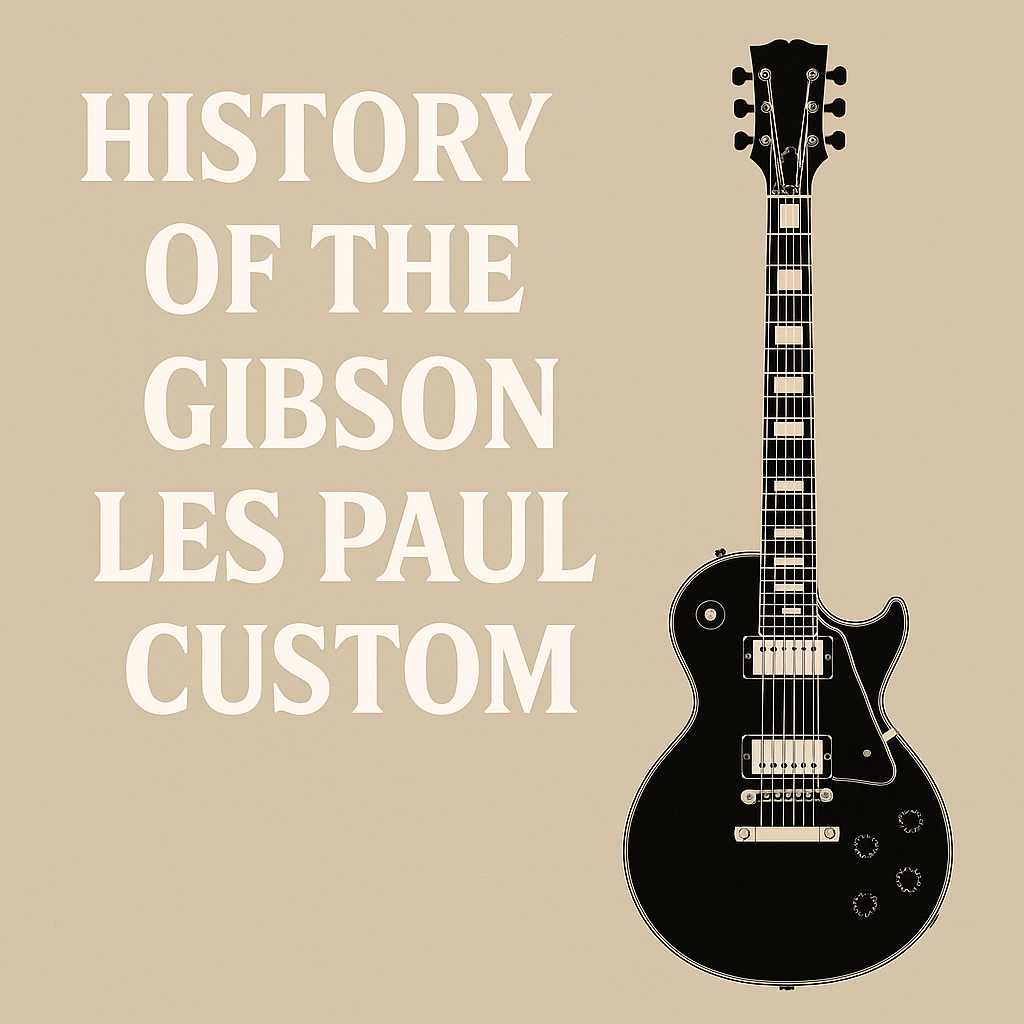The Gibson Les Paul Custom, often dubbed the “Black Beauty,” has been a cornerstone of electric guitar history since its introduction in the 1950s. Designed as a more upscale version of the original Les Paul model, the Custom has undergone numerous specification changes over the decades—each reflecting shifts in musical trends, player preferences, and Gibson’s own evolution as a company. Let’s take a look at the history and changing specs of this iconic instrument, and the legendary players who made it famous.
1954: The Birth of the Black Beauty
The original Gibson Les Paul Custom debuted in 1954, marketed as the “tuxedo” version of the standard goldtop Les Paul. Key specs included:
-
Solid mahogany body and mahogany top (unlike the maple top on the Standard)
-
Ebony fretboard (a first for Gibson Les Pauls)
-
Gold hardware and multi-ply binding
-
“Staple” Alnico V neck pickup paired with a P-90 bridge pickup
-
Tune-O-Matic bridge (introduced shortly after in 1955)
This guitar was designed for jazz and studio musicians who wanted a more refined, elegant look and a smoother sound.
1957: The Humbucking Revolution
Perhaps the most important change came in 1957, when Gibson introduced PAF (Patent Applied For) humbuckers:
-
The Custom now featured dual or triple humbuckers (usually two).
-
These pickups provided a fatter, quieter tone compared to single-coils.
-
1957–1960 models are now some of the most sought-after vintage guitars on the planet.
1960s–Early 1970s: Decline and Resurrection
In 1961, Gibson discontinued the original Les Paul shape, replacing it with what would become the SG. Les Paul himself objected to the new design, and his name was briefly removed from the model.
-
From 1961 to 1968, the Les Paul Custom as originally known was not produced.
-
In 1968, the Les Paul Custom was reissued with several new specs:
-
Maple top and mahogany body (a return to Standard-style construction)
-
Three-piece mahogany neck
-
Narrower headstock
-
Still featured ebony fingerboard and block inlays
-
Mid-1970s to Early 1980s: Norlin Era Changes
The Norlin era (1969–1986) brought several controversial changes:
-
Pancake body construction (multiple pieces of wood glued together)
-
Volute added to neck for stability (around 1970)
-
Heavier guitars due to maple necks and additional weight relief not yet being standard
-
Still used T-Top humbuckers and then transitioned to Shaw PAFs in the early 1980s
Despite these changes, many rock and metal players gravitated to the Les Paul Custom for its thick, sustaining tone and luxurious feel.
1990s–2000s: Return to Tradition and Modern Features
By the 1990s, Gibson began returning to more vintage-correct specs:
-
One-piece mahogany bodies with maple tops
-
Ebony fretboards remained standard (until shortages pushed some models to Richlite later)
-
Introduction of Custom Shop Historic Reissues with period-accurate specs (e.g., 1957 LP Custom Reissue)
In the 2000s, Gibson experimented with modern electronics and weight-relief techniques (chambering or modern weight-relief), aiming for better comfort while preserving tone.
2010s–Present: Historic Reissues and Modern Customs
Today’s Les Paul Customs are split between:
-
Custom Shop Historic Reissues:
-
Built to replicate original specs from 1954–1960
-
Hand-wired electronics, vintage-correct neck profiles, nitrocellulose finishes
-
-
Modern Les Paul Customs (USA-made):
-
Richlite fretboards (recently returning to ebony)
-
Weight-relief bodies for comfort
-
498T/490R pickups or Burstbuckers depending on year/model
-
Often more affordable than Custom Shop versions
-
Famous Les Paul Custom Players
The Les Paul Custom has been favoured by legends across genres. Notable players include:
-
Randy Rhoads – His white Les Paul Custom helped define Ozzy Osbourne’s early solo sound.
-
Peter Frampton – His iconic triple-humbucker black Custom became synonymous with his tone.
-
Zakk Wylde – Known for his bullseye-painted Les Paul Customs and crushing heavy riffs.
-
Ace Frehley – Used a three-pickup Custom during KISS’s heyday.
-
Adam Jones (Tool) – His silverburst Custom became so iconic that Gibson reissued it as a signature model.
-
Jimmy Page, Slash, and Bob Marley all played Customs at various points, although they are more closely associated with Les Paul Standards.
Conclusion
The Gibson Les Paul Custom has remained a symbol of class, craftsmanship, and power. Whether in the hands of a jazz virtuoso or a heavy metal shredder, it continues to evolve without losing its timeless appeal. For many players, it’s not just a guitar—it’s the guitar.









